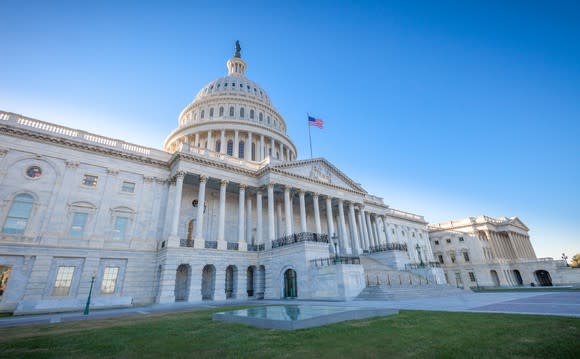The Single Most Terrifying Social Security Chart
When discussing the most important social program in the U.S., Social Security probably rises to the top of the pack. As of February, according to snapshot data from the Social Security Administration (SSA), more than 62 million people were receiving Social Security benefits, including almost 43 million seniors.
Yet this vital program counted on by the elderly during retirement, as well as by survivors of deceased workers and by the disabled, isn't in the best long-term shape. In fact, if the 2017 report from the Social Security Board of Trustees is accurate, the program may be in downright deep trouble.

Image source: Getty Images.
Social Security is just 16 years away from big problems
According to the report released last summer, Social Security is expected to begin paying out more in benefits than it's generating in revenue by 2022 -- four years from now. Just 12 years later, in 2034, Social Security is projected to have completely exhausted its asset reserves, which by 2022 should peak around $3 trillion. Without these asset reserves in the program's back pocket, the trustees estimate there could possibly be an across-the-board cut in benefits of up to 23%. That's a terrifying outlook for tens of millions of beneficiaries, as well as the more than 15 million retirees who are currently being kept out of poverty as a result of their monthly Social Security benefit, per the Center on Budget and Policy Priorities.
Why is Social Security facing such issues? It really is a confluence of a number of factors. In no particular order, these include:
The ongoing retirement of baby boomers, which is weighing down the worker-to-beneficiary ratio.
A relatively steady increase in longevity since the Social Security Act was signed into law.
Exacerbated income inequality that's allowed the wealthy to pull a sizable payment from Social Security for an extended period of time.
An extended period when the Federal Reserve held the federal funds target rate at a record low, thus lowering interest income on asset reserves.
And the inability of Democrats and Republicans in Congress to agree on virtually anything when it comes to Social Security, even though each party has a core proposal that would fix the current $12.5 trillion long-term (75-year) cash shortfall.
Given Social Security's seemingly imminent issues, you'd think working Americans and retirees would have prepared for a possible cut to benefits. Unfortunately, data from the SSA suggests otherwise.
The scariest Social Security chart
Below, in what might well be described as the single most terrifying Social Security chart you'll ever see, is SSA data on Social Security's importance for retirees, as of March 2016.

Image source: Social Security Administration.
What you'll note is that both married and unmarried beneficiaries are reliant on their Social Security checks for at least half their total income. Half of all married beneficiaries, and close to three-quarters of all unmarried elderly persons, lean on Social Security as their primary income source.
What's more, over a third of total beneficiaries, including 23% of married couples and a whopping 43% of unmarried individuals, rely on their monthly check for between 90% and 100% of their income.
This is worrisome for two reasons. First, the SSA recommends that the average retirees rely on Social Security to replace only about 40% of their working wage. Admittedly, lower-income workers might lean on Social Security for a slightly higher percentage, and higher-income workers for a lower percentage. Either way, the key point is that Social Security was never designed to be a primary income source, as so many have made it today.
The other issue, as described earlier, is that Social Security could be just 16 years away from an across-the-board cut in benefits of up to 23%. If a majority of the elderly used Social Security as only a minor source of income, a 23% cut would be unpleasant, but not a game-changer. However, with over a third of elderly beneficiaries reliant on the program for essentially all of their income, and 62% leaning on Social Security for at least half their income, that 23% cut in benefits could prove devastating.

Image source: Getty Images.
Congress has to act
Given that so many of today's elderly are reliant on Social Security, and 79% of future retirees are expected to lean on the program as a major or minor source of income, per Gallup, Congress has no choice but to act sooner rather than later to resolve Social Security's long-term cash shortfall.
The biggest issue for lawmakers is that each party has a workable solution. Democrats have proposed increasing or eliminating the maximum taxable earnings cap associated with Social Security's payroll tax. This 12.4% payroll tax currently applies to earned income up to $128,400, allowing the small percentage of workers who earn in excess of $128,400 to escape Social Security's payroll tax on this additional income. Raising or eliminating this taxable cap would simply require the wealthy to pay more, which would raise revenue for the program.
Comparably, the GOP envisions increasing the full retirement age, or the age at which the SSA deems that persons are eligible to receive 100% of their retirement benefit, as determined by their birth year. When signed into law in 1935, Social Security was only expected to provide benefits to retirees for a few years. Today, according to the SSA, seniors who reach age 65 will live an average of 20 more years. With the program not designed to support decades of payments, Republicans propose increasing the full retirement age. This would entice people to either wait longer to claim full benefits, or to claim early and accept an even steeper payout reduction. Either way, it would reduce long-term expenditures for the program.
Both of these plans work, but they'd probably work best in moderation. If Congress could find a middle ground that requires the wealthy to pay more, while also adjusting the program to factor in increased longevity, current and future retirees might be saved from any notable cut to their benefits.
In other words, your move, Congress.
More From The Motley Fool
The Motley Fool has a disclosure policy.
